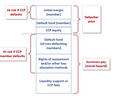Hello,
I was just comparing Default fund contribution Waterfall losses chart from the video with the GARP textbook. The sequence in both is different.
Based the book - the funds are used in the following order:
In the video:
As showing in the learning video at 18mins.

I was just comparing Default fund contribution Waterfall losses chart from the video with the GARP textbook. The sequence in both is different.
Based the book - the funds are used in the following order:
- Initial margin provided by the member,
- Default fund contribution of the member,
- Default fund contributions of other members, and
- Equity capital of the exchange
In the video:
- Initial margin provided by the member,
- Default fund contribution of the member
- Equity capital of the exchange, and
- Default fund contributions of other members
As showing in the learning video at 18mins.

